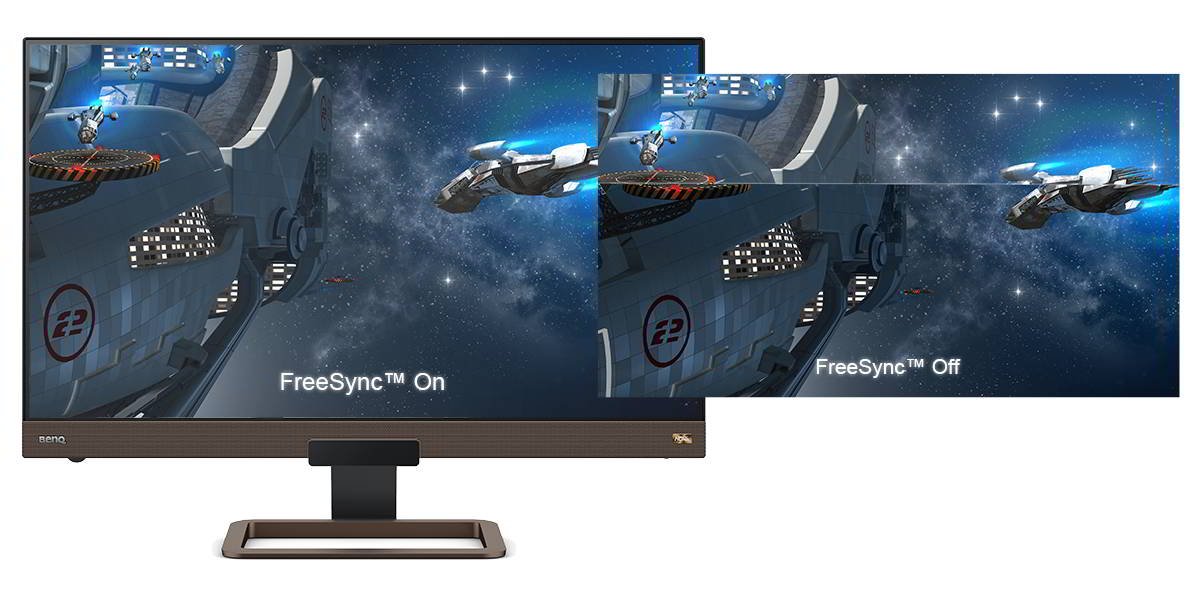

There may be some confusion concerning FreeSync and FreeSync 2. These were the names used by AMD up until late 2019. FreeSync remains the basic tier, while FreeSync 2 was renamed into two levels, known now as FreeSync Premium and FreeSync Premium Pro.

Back in 2014-2015, AMD responded to NVIDIA’s G-Sync variable refresh rate technology with FreeSync. Based on VESA Adaptive Sync, FreeSync aims to eliminate screen tearing (primarily in gaming applications) and unwanted differences between the framerates of graphics cards and monitors. Display manufacturers add FreeSync processing to monitors to provide hardware variable refresh rate support without any performance penalty on the graphics card side. Currently, three levels of FreeSync exist: basic, Premium, and Premium Pro. As the names imply, they support increasingly sophisticated features as you go up the list, from basic adaptive sync to high framerates and certified HDR input and output. Native HDR hardware support is exclusive to FreeSync Premium Pro. Additionally, FreeSync Premium and Premium Pro have low framerate compensation, or LFC. FreeSync technology exists mostly on PC, but also on post-2017 Xbox One consoles and next generation Xbox and PlayStation models.
With FreeSync, if your monitor supports smooth 144Hz gaming but your graphics card only goes up to 120Hz, for example, the monitor automatically syncs to 120Hz instead of “waiting” for the graphics card to catch up. That stops annoying screen tearing from taking place, ensuring you always have a consistently smooth framerate for your games.
All levels of FreeSync offer hardware-level adaptive sync, although the basic FreeSync version was designed for 60Hz initially. With FreeSync Premium and Premium Pro, higher framerates enjoy better support. In fact, both higher tiers have a minimum of 120Hz for full HD 1080p displays. That is, FreeSync Premium/Premium Pro can only be added to 1080p monitors with refresh rates higher than 120Hz. For 4K screens, that minimum doesn’t apply. That’s because for now, 4K monitors emphasize resolution and visual fidelity over raw framerate. This will inevitably change as graphics hardware becomes more powerful and 8K becomes the dominant resolution.
Another common feature of FreeSync Premium and Premium Pro is LFC, or low framerate compensation. This works very much like motion enhancement and compensation on TVs and prevents judder due to missing frames. Based on your monitor’s detected refresh rate range, FreeSync technology compensates for drops below that range’s minimum. If your display varies between 60Hz and 120Hz, Free Sync Premium/Premium Pro will add frames if lower refresh than 60Hz occurs. Unlike with TV and movies, video games generally don’t suffer from the soap opera effect due to artificially inserted frames, meaning discomfort or image compromise are very unlikely.
Basic FreeSync doesn’t have LFC, just to be clear.
FreeSync Premium Pro, the highest tier, has exclusive access to high dynamic range and wide color gamut support. To clarify, FreeSync and FreeSync Premium features may not work when HDR is turned on due to processing bandwidth issues. Or they may work at the cost of inconsistent HDR performance (your PC, console, or monitor may need to disable HDR to keep FreeSync features working). At any rate, the two lower tiers of FreeSync work independently of HDR, while FreeSync Premium Pro integrates HDR on the hardware level. That allows you to enjoy every FreeSync feature we’ve mentioned plus better HDR performance. That’s because the hardware-level negotiation between your monitor and PC/consoles gets a helping hand from the FreeSync Premium Pro process, alleviating some of the computational burden. If you want to game with HDR on, FreeSync Premium Pro is the best choice. If shopping for a DisplayHDR-certified monitor, you should try to get one with FreeSync Premium Pro to better leverage its capabilities.
FreeSync Premium Pro should be the only choice anyway because all levels of FreeSync remain “free” in essence. AMD doesn’t charge monitor makers for the technology, although obviously the additional processing components do have a cost. But as a royalty-less technology, you may as well get the highest tier because the price difference tends to come out unsubstantial. Bottom line: since HDR in games will only increase in importance, FreeSync Premium Pro will become the baseline eventually, and you should aim for that.
Do remember FreeSync tech overall isn’t mandatory and you can have an excellent gaming experience without it. FreeSync doesn’t generate graphics processing power, rather it helps your hardware platforms and refines their behavior. Furthermore, HDMI 2.1 and DisplayPort 1.4 on their own deliver native variable refresh rate without any additional technology needed, independent of FreeSync or G-Sync, and they’re set to become much more popular. No matter what, the future looks good for smooth gaming with consistent framerates, so there’s cause for joy there.
{{title}}
We will notify you when we have more.
We will send you an email once the product become available.Your email will not be shared with anyone else.
Sorry, our store is currently down for maintenance.We should be back shortly. Thank you for your patience!